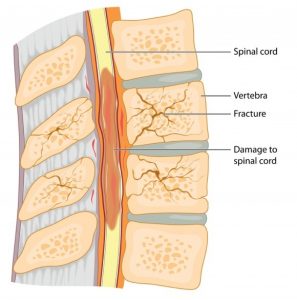 Spinal fractures are extremely serious conditions that can lead to a wide variety of symptoms, ranging from mild in intensity to debilitating. Sudden trauma, as well as underlying medical conditions, may be to blame.
Spinal fractures are extremely serious conditions that can lead to a wide variety of symptoms, ranging from mild in intensity to debilitating. Sudden trauma, as well as underlying medical conditions, may be to blame.
Luckily, there are both surgical and nonsurgical avenues available to address spinal fractures.
Like just about any bone in the body, vertebrae can potentially break or crack. Spinal fractures occur when an outside force applies too much pressure to a bone. In many cases, the front of the spine collapses while the posterior portion maintains its height. These wedge-shaped fractures, especially when occurring in multiple vertebrae, can lead to noticeable spinal deformities like a hunched back.
For some, spinal fractures are the result of an accident or trauma. High-energy traumas push the spine past its breaking point.
In many cases, additional injuries are present during trauma-related spinal fractures. Severe spinal fractures could include spinal cord injuries which, when left untreated, can lead to permanent damage.
Also one does not need to experience a bad accident to suffer spinal fractures. Underlying medical conditions can make the vertebrae more likely to break.
- Osteoporosis: As we age, our bones lose density and begin to weaken. Pressure can cause weak vertebral bodies to crack and lose their height. Even everyday activities like twisting, reaching, or even sneezing can lead to spinal fractures.
- Cancer: Those suffering from many forms of cancer can have the disease spread to the spine. As tumors expand in size within the spine, vertebrae can suffer breaks.
- Infection: While less common, infections in or near the spine may weaken the bones, causing fractures.
- Medications: Certain drugs like oral steroids, antidepressants, or diabetes medications can weaken the bones.
Osteoporosis is commonly called the “fragile bone disease.” It is due to loss of bone density caused by a deficiency in such bone-building nutrients as calcium, vitamin D, magnesium and other vitamins and minerals. One of the most common results of fragile bones is vertebral compression fractures. While these types of fractures can be the result of trauma or tumors, they are seen most often in people with osteoporosis. In people with advanced osteoporosis, compression fractures can occur as the result of simple daily activities such as bending, carrying heavy loads, or a minor fall.
Symptoms of spinal fractures can vary depending on the location and severity of the injury. In most cases, one will experience some degree of pain. Pain may also be a sign of injuries to nerves, nerve roots, or the spinal cord itself.Other symptoms associated with spinal fractures include:
- Neck or back pain occurring suddenly—especially after a fall or accident
- Worsening pain while standing or walking
- Some pain relief while lying down
- Muscle spasms
- Numbness or tingling in other areas of the body including arms, hands, legs, and feet
- Height loss
- Limited mobility and range of motion
- Noticeable deformity of the spine (e.g. posture)
- Trouble controlling bowels or bladder
- Paralysis—a loss of movement in an extremity due to a spinal cord injury
We will likely use a variety of diagnostic imaging techniques to visualize the structures of your spine. These techniques include:
X-rays: Simple images of the bones created by using electromagnetic waves.
CT scan: A computer axial tomography uses x-rays and a computer to produce vivid cross-sectional images of the body. These scans help us determine if the bone is stable and if any nearby nerves are affected.
MRI scan: The magnetic resonance imaging scan uses radio waves and a magnetic field to create detailed images of the soft tissues inside the body. These images show if the tissues involved include intervertebral discs and whether the fracture is new or old.
Treatment for spinal fractures depends on the severity of your injury and the associated symptoms.
If the fracture is relatively stable, then your doctor may recommend a brace. Braces can also help to control pain by restricting the movement of the injured area.
If the fracture is non healing or unstable surgery may be recommended.
Three types of procedures can be performed:-
- Vertebroplasty :- During vertebroplasty, the bone cement is injected into the collapsed vertebral body. The bone cement rapidly sets, hardens and stabilizes the spinal fracture. Vertebroplasty can help to relieve pain and may strengthen other vertebral bodies at risk for fracture.
- Kyphoplasty :- A thin tube is inserted into the collapsed vertebra. Attached to the tube is a small balloon that, when inflated, moves the broken bone and creates an open space. The balloon is removed, and the space is filled with thick, liquid bone cement. Balloon kyphoplasty can help relieve back pain and stabilize the vertebral compression spinal fracture.
- Spinal Fusion :- Sometimes, a vertebral compression fracture does not heal properly. In such a case we may recommend a procedure that includes spinal fusion. Spinal fusion joins two or more vertebrae together. The surgical procedure may include instrumentation (eg, screws, rods, interbody devices) and bone graft.







